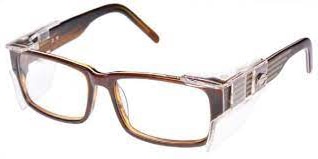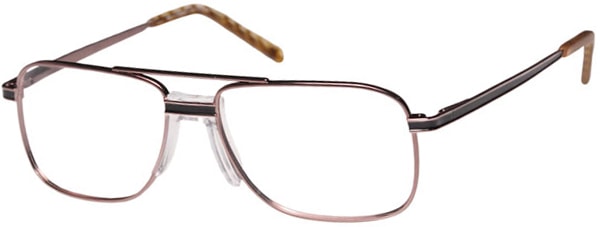- Safety Glasses
- Sports
- Sunglasses
- Eyeglasses
- Safety Products
- Accessories




Prescription safety glasses make many industries much safer to work in. Many jobs expose the worker to potential harm and permanent damage without the protection of safety glasses. Some of these jobs or industries include:
Risks associated with these jobs are:
Protecting the eyes from unsafe environments and jobs such as the ones named above has been the main feature of safety glasses. “According to the U.S. Bureau of Labor Statistics, more than 20,000 workplace eye injuries happen every year.” Without safety glasses that number would surely be much higher. The American Academy of Ophthalmology states that the use of safety glasses can reduce about 90% of accidents involving the eyes.
Eye safety was not always a possibility in the past. People who worked in dangerous conditions would lose an eye or go blind in some situations. The invention of glasses is an interesting and important part of history on which we have come to rely. The Optical Heritage Museum Web Site has a thorough timeline – complete with pictures – explaining the history of safety eyewear.
The roots of eyewear creation begin with Hasan Alhazen an Arab scientist and astronomer. He discovered how light reflects off objects and are picked up by the eye. From his studies into optics, he theorized that a convex lens could enlarge an image. His book entitled, Alhazen’s Book of Optics, directly influenced others to continue the study of magnifying objects. This led to first known invention of eyeglasses in 1286 in Italy. However, the first inventor is unknown and documents reflect the person did not want to share the invention with others. However, shortly after this Alessandro della Spina discovered how to make eyeglasses and he spread the information with others.
Early glasses were crude in their structure consisting simply of two magnifying glasses put together with handles so they could rest on the nose or be held up to the eyes.
In the early beginnings of eyewear, glasses were not a stylish item. From 1268 to the mid-1400’s there were only two types of designs: ones you could hold up to your eyes or ones that hooked on your nose and balanced there. The subsequent designs came because the advent of the printing press in 1452 brought about increased literacy and access to books. The desire for reading led to the need for more convenient designs. It was difficult to hold or balance the glasses for extended periods so pieces were made to extend over the person’s ears.
During this time, glasses continued to be constructed by hand. Two important developments occurred during the 1700’s. Glasses now had pieces connected to the lenses that rested over the person’s ears. This provided the user with increased stability. Also, Benjamin Franklin invented the bifocals in the late 1700’s, which allowed a user to see objects at a distant and nearby equally as well. Ben Franklin needed bifocals and wrote to a friend that he was “happy in the invention of double spectacles, which serving for distant objects as well as near ones, make my eyes as useful to me as ever they were.”
Three common designs during the 1700’s were:
These glasses utilized a cattle horn for circular lens inserts.
These were popular with the men who wore wigs because the “temple pieces extended far beyond the ears.”
This style looks like a pair of scissors with lenses placed in the handle. These were popular with people who did not want to wear glasses. It allowed the person had to hold them up to their eyes.
At the end of this century, eyewear manufacturing produced larger quantities glasses. However, many people purchased them from traveling salespeople, general stores, and jewelers, which used cheaper materials.
Another thing that influenced glasses during this time was how people felt about them. The 1800’s was a time when people felt wearing glasses meant you were old. Thus, the Lorgnette style of glasses emerged. This type of eyewear looked similar to the scissor design. The eyepieces connected to a handle for holding. However, in 1830 a French designer found a way to put a hinge on the bridge of the eyeglasses so they could fold up. This style was especially popular with women who did not want to be seen wearing glasses.
A few different factors influenced glasses in this century. For one thing, better materials, such as plastics, were discovered for making glasses. Hollywood and celebrities affected the glasses industry for the good. People saw Hollywood stars sporting stylish glasses and this helped make them not only more acceptable but desirable. The last factor affecting glasses was the ability to mass-produce them; glasses carved out industry of its own.
People began to wear their glasses all the time instead of just when they felt they needed them. The popular style during this time was the “pince-nez.” It was a French style meaning “pinch nose” because they literally did pinch the nose a bit. The reason they did was that they did not have any piece that connected over the ears. They rested tightly over the bridge of the nose. Popular U.S. figures Teddy Roosevelt and Calvin Coolidge wore them consistently and fueled their popularity.
During this period, Hollywood encouraged temple spectacles back into the spotlight. Sunglasses made their debut in the 1930’s. As plastic manufacturing sped up so did the glasses industry. By the 1940’s, glasses were readily available in multiple colors and styles. Now people felt they could wear glasses and be stylish.
Glasses became a regular part of a person’s life and were made to fit a person’s “look.” Just as clothing styles changed periodically, glasses changed as well.
Interestingly, the advent of motorized transportation ushered in the invention of goggles, which were the first form of safety glasses. Railroad engineers often had the debris such as coal, dust, and rocks striking their eyes and were in need of protection. Pilots who navigated the skies in planes without cabins needed a covering for their eyes too. Even automobiles were open exposing the driver to the elements.
Safety glasses weren’t technically invented though until 1914. Garrett Morgan invented what he called a breathing device. It consisted of a hood, goggle-like glasses, and a breathing apparatus for the mouth. Morgan marketed the mask to firefighters to protect them going into dangerous, smoke-filled areas. This early creation spawned the invention of gas masks used in WWI and then later the safety goggles. Although Morgan didn’t get much credit at the time for his creations due to the fact he was African American, his invention saved many people from damage to their eyes. Before safety glasses came on the scene people suffered severe damage to their eyes in certain settings.
Today, prescription safety glasses are a great asset for anyone working in dangerous industries or for those who live active lifestyles. Connect with Rx-Safety for more information about obtaining your prescription safety glasses today!
Stay on top of the latest news about prescription safety glasses, eyewear, sunglasses, and all the trends in the industry.
DISCOVER NOWBe the first one to know about promotion, new products, and more.
Follow Us On Instagram @rx_safety
